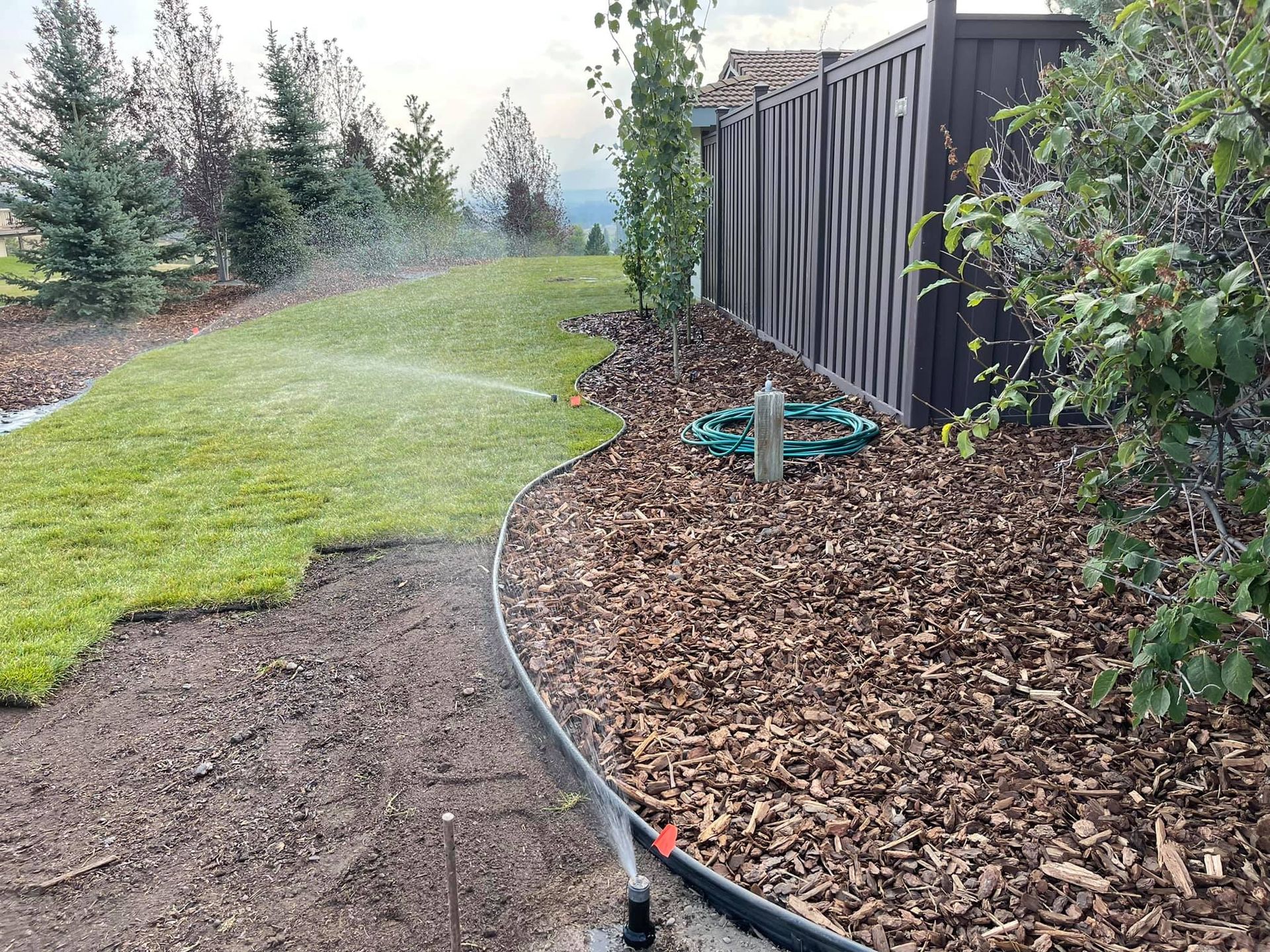
Table of Contents
- The Challenge of Summer Lawn Care
- Why Smart Lawn Irrigation Makes the Difference
- Understanding Soil Moisture and Water Retention
- Crafting the Perfect Summer Lawn Maintenance Schedule
- Sprinkler System Care: Keeping Equipment Working at Its Best
- Common Mistakes Homeowners Make with Lawn Watering
- Simple Ways to Save Water Without Sacrificing Green
- When It’s Time to Call in Lawn Irrigation Experts
Key Takeaways
- Proper lawn irrigation ensures even hydration, helping grass stay lush and healthy during hot months.
- Smart summer lawn maintenance involves timing, technique, and soil management—not just frequent watering.
- Consistent sprinkler system care prevents wasted water and patchy lawns.
- A well-maintained system saves money, conserves resources, and keeps your yard looking its best all season.
The Challenge of Summer Lawn Care
Every summer, we hear the same story from homeowners: “No matter how much I water, my lawn still turns brown.” It’s frustrating—especially when you’re investing time and money trying to do everything right. The truth is, hot weather and inconsistent watering habits can quickly undo months of effort.
Keeping your grass green through July and August isn’t about drenching it daily. It’s about knowing how, when, and where to water so your lawn can thrive under the summer sun. With the right approach to lawn irrigation, you can keep every blade of grass strong, even when the temperature climbs.
Over the years, we’ve helped plenty of homeowners in our community transform dull, dry yards into vibrant, resilient lawns. The secret? Smart watering practices that match the soil, the season, and the specific needs of your grass type. If you’re interested in saving time and getting professional results, our team offers professional irrigation services designed to take the guesswork out of summer lawn care.
Why Smart Lawn Irrigation Makes the Difference
Think of lawn irrigation as the heartbeat of your yard. It doesn’t just deliver water—it determines how well that water supports the roots beneath the surface. Too little, and your grass wilts. Too much, and roots drown, inviting disease and fungus.
We’ve seen how small adjustments—like switching to early morning watering or updating an outdated sprinkler head—can completely change the look of a lawn. It’s not about high-tech systems or constant watering; it’s about efficiency and consistency.
A well-designed irrigation plan ensures your grass gets deep, even hydration. Instead of shallow roots that rely on daily sprinkling, you’ll encourage growth that can handle the heat. In other words, the goal isn’t just a greener lawn today—it’s a tougher, healthier one for the entire season.
Understanding Soil Moisture and Water Retention
When we inspect lawns in mid-summer, one of the first things we check is soil condition. You’d be surprised how much of your watering effort gets lost before it even reaches the roots.
Healthy soil acts like a sponge—it absorbs water slowly, holds it evenly, and releases it when roots need it most. But compacted or sandy soil? That’s a different story. Water tends to run off the surface or drain too fast.
A simple test can tell you a lot: grab a screwdriver and push it into your lawn. If it slides in easily, the soil is in good shape. If it resists, the ground is likely compacted. Aerating the soil once or twice a year can help improve water absorption dramatically.
We often remind homeowners that summer lawn maintenance doesn’t stop at watering. Keeping soil healthy through aeration and organic composting helps the entire irrigation process work more effectively. When your soil breathes, your grass thrives.
Crafting the Perfect Summer Lawn Maintenance Schedule
Watering schedules are where most homeowners slip up. Many assume daily watering is best, but that’s rarely true. Shallow, frequent watering encourages weak roots that can’t survive long heat waves.
We recommend deep watering two to three times a week, depending on your region’s weather. That means letting your sprinkler system run long enough for moisture to soak six inches deep. You can check this by digging a small patch after watering—if it’s moist at that depth, you’re right on track.
The best time of day to water is early morning, ideally before 9 a.m. That gives the grass plenty of time to dry before the evening, reducing the risk of fungus. Evening watering may seem convenient, but it traps moisture overnight, which can invite lawn diseases.
If your area experiences water restrictions, adjust your schedule accordingly. Modern irrigation controllers make this easy—you can program them to alternate days or adjust based on rainfall. The trick is consistency. Even during dry spells, a reliable watering rhythm keeps the grass stable and stress-free.
Sprinkler System Care: Keeping Equipment Working at Its Best
Your sprinkler system care routine is just as important as watering itself. A clogged or misaligned head can throw off the entire system, leaving some areas parched and others soggy.
We’ve seen countless cases where homeowners thought they had watering issues—only to discover half their sprinkler heads weren’t rotating or were blocked by overgrown grass. A quick inspection every few weeks can save you both water and frustration.
Here’s what we look for during maintenance:
- Check that each sprinkler head covers its intended zone evenly.
- Clean nozzles and filters to prevent clogging.
- Adjust spray angles to avoid wasting water on sidewalks or driveways.
- Watch for leaks or pressure drops that may indicate broken pipes underground.
You don’t need fancy equipment—just a little time and observation. A well-maintained system not only keeps your lawn green but also helps conserve thousands of gallons of water over the season.
If you’re unsure about your setup or think your system may need an upgrade, consider scheduling an inspection through our professional irrigation services to make sure everything’s running smoothly.
Common Mistakes Homeowners Make with Lawn Watering
We’ve noticed certain patterns over the years. People often mean well but unintentionally create conditions that stress their lawns. Here are a few habits we recommend avoiding:
- Watering at the wrong time.
Late evening watering keeps the grass wet overnight, encouraging disease. Early morning is always best. - Ignoring rainfall.
If your area gets a heavy downpour, skip your next scheduled irrigation. Overwatering is just as harmful as neglect. - Using identical watering times across all zones.
Different areas of your yard have different needs. Shadier spots retain moisture longer than sun-exposed ones. Adjust accordingly. - Relying solely on sprinklers.
Sprinklers are great for even coverage, but they can’t fix compacted soil or poor drainage. Think of irrigation as part of a bigger maintenance strategy. - Forgetting system maintenance.
A single broken head can waste hundreds of gallons in a week. Routine checks prevent costly water loss.
Avoiding these mistakes is often the difference between a dull, patchy lawn and one that looks like it’s been cared for by professionals.
Simple Ways to Save Water Without Sacrificing Green
We understand the hesitation some homeowners have about watering during hot, dry months—especially when local water costs rise. The good news is, smart lawn irrigation doesn’t have to mean high water bills.
Start by checking for leaks and adjusting your sprinkler heads for efficiency. Make sure you’re not watering sidewalks, fences, or driveways. It sounds obvious, but we see it all the time.
Consider investing in a rain sensor or moisture controller. These small devices automatically pause irrigation during or after rain, preventing waste.
Another smart habit is mulching. A thin layer of mulch around the edges of your lawn or flower beds helps the soil retain moisture and reduces evaporation. We often remind customers that shade from healthy trees and shrubs can also protect grass from excessive drying.
Finally, raising your mower blade slightly can make a big difference. Taller grass shades the soil, keeping it cooler and reducing the need for constant watering. A small change in mowing height often means fewer watering sessions per week.
When It’s Time to Call in Lawn Irrigation Experts
There’s a point where DIY lawn care reaches its limit. If you’ve tried adjusting schedules, repairing sprinklers, and your grass still looks uneven, it might be time to bring in professionals who specialize in summer lawn maintenance and irrigation systems.
We often help homeowners who are tired of chasing symptoms—brown spots, runoff, uneven growth—without realizing the problem lies beneath the surface. Whether it’s uneven soil, outdated equipment, or improper pressure settings, professional inspection can reveal issues that aren’t visible from above ground.
At Two Brothers Lawn and Snow, LLC, we’ve spent years working with homeowners who just want their lawns to look consistently green without wasting water or energy. We don’t just fix systems; we tailor them to your property’s unique layout and soil composition. The goal is always efficiency and long-term health.
A professional tune-up before summer hits can ensure your system runs smoothly all season. We check everything from water pressure to head calibration, ensuring each zone is balanced for maximum coverage. You’d be amazed how much greener your lawn looks once the system is working in harmony with the weather and soil.
For expert help or to book an appointment, contact us today and let our team handle the rest.
Final Thoughts
Keeping a lawn green through the summer isn’t just about effort—it’s about understanding. Once you grasp how water, soil, and timing work together, everything changes. Your yard becomes more than just something you maintain; it becomes an environment that thrives naturally.
We’ve seen it time and again—homeowners who struggled for years finally get the results they’ve been hoping for with a few smart adjustments. That’s the beauty of good lawn irrigation and thoughtful summer lawn maintenance. When everything’s tuned just right, your grass rewards you with color, texture, and resilience that lasts from the first heat wave to the last warm day of fall.
If you’re ready to see what professional irrigation can do for your property, reach out to us today. You can visit or call us at (406) 369-4114, or send an email through support@twobrotherslawnandsnow.com to schedule an appointment.
Let’s keep your lawn thriving—together.
Frequently Asked Questions
Why is lawn care in Montana different from other states?
We approach lawn care in Montana differently because our weather is extreme—hot, dry summers and long, cold winters. That means we adapt our soil prep, watering, and fertilization methods to build lawns that stay resilient all year.
What does seasonal lawn maintenance involve?
Our seasonal lawn maintenance focuses on timing tasks for each season—spring aeration, summer mowing and watering, fall fertilization, and winter protection. This rhythm keeps lawns strong, prevents bare spots, and makes care easier over time.
How can we improve grass care at home?
We recommend sharpening mower blades, mowing higher, and rotating mowing patterns as part of everyday grass care. These simple habits reduce stress on your lawn and make it healthier and greener, even in Montana’s challenging climate.
Which grass types thrive best in Montana?
For effective grass care, we choose hardy blends like Kentucky bluegrass, fine fescue, and perennial ryegrass. These varieties handle drought, cold, and heavy use—perfect for Montana’s climate. The right seed mix makes all the difference.
Why should we hire a professional for lawn care Montana?
Working with experts in lawn care Montana saves time, avoids costly mistakes, and ensures your lawn gets what it needs each season. We bring the right tools, knowledge, and experience to keep lawns green, healthy, and resilient.
